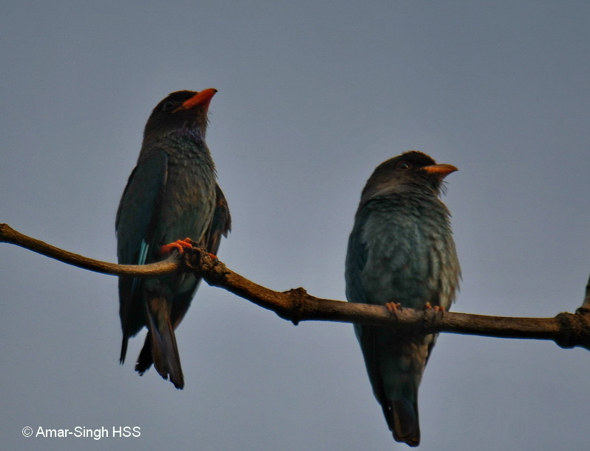“The image above shows a juvenile and that below a juvenile (at right) with an adult. The juvenile bill is usually black, with an orange tip. These two juveniles I saw are more mature and the lower mandible has turned orange; the upper an orange black. The feet are still largely dark, but the second juvenile (not shown) had more orange feet and bill suggesting it is older (this was the one fed less often). Both juveniles have yet to develop the light blue wing ‘window’ seen at rest (see images of adult with juveniles and the two side by side HERE).
“I was out cycling today with my wife and stopped by the site to watch this family. Both yesterday and today, one juvenile was fed more than the other, even when the two juveniles were separated some distance apart (parent would take the trouble to go to less mature juvenile to feed it). We also noticed that the success rate to capture insects by the parent is almost 100%. Not seen a single failure for aerial sallies I observed yesterday and today. Image below is another of the parent with prey in better light. Have yet to see the second parent.
“As expected, feeding frequency decreased from every 2-5 minutes (6.3-7.30am) to every 10-15 minutes (8.30-9.30am) later in morning. Possibly due to decrease in visibility of prey (many moths and beetles are nocturnal) as well as juveniles could be satiated. Some images of feeding, parents with food and a close up of juvenile.
“I managed a couple of videos one edited segment is shown below. Lots of background noise from vehicles and my DSLR camera clicks which are hard to edit out as keen to keep the juvenile calls intact. In the middle of the video there is feeding episode.
“Below is a juvenile in flight – note that you cannot see the bright orange feet clearly as you would an adult in flight.
Dato’ Dr Amar-Singh HSS
Ipoh, Perak, Malaysia
9th March 2019
Location: Ipoh, Perak, Malaysia
Habitat: Urban environment













